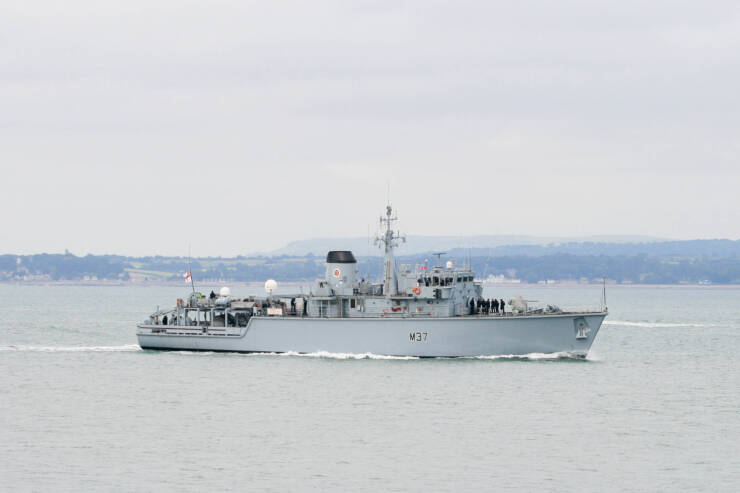
News reports of December 2020 indicate that the Indian Navy is looking at leasing an unspecified number of mine counter measure vessels (MCMVs) in addition to other equipment to fill critical gaps. For example, the Navy has taken on lease 2 x Sea Guardian drones from the US and leased a logistics ship from an Indian private firm. The Navy which at one time had 12 X MCMVs has none today and is constrained to depend on kits fitted on small ships to counter the mine threat.
Navy’s attempts to procure MCMVs from South Korea since 2005 have been unsuccessful due to controversies and the issue of transfer of technology (ToT). MCMVs are used to clear harbours and other critical areas of mines laid by enemy submarines and vessels. According to a naval source, “The leasing is not just for training and familiarisation process. There are certain areas where there is a huge capability gap. While the larger procurement process is on to fill the gaps, leasing of such equipment can be used in the interim period.”
The Parliament’s Standing Committee for Defence report in 2017 had revealed that Navy’s last six MCMVs would be de-commissioned in 2018. These were slated for de-commissioning by 2016-2018. The committee felt that the entire process of procurement of MCMVs will be delayed inordinately. The Committee had asked the government to make “sincere and concerted efforts” to equip the Navy with the critical capability. The worrying part then was that the Navy would be without minesweeping capability till at least year 2021. There was also speculation then that India could sign a Rs 32,640-crore deal with a South Korean shipyard for building 12 x MCMVs in the country. But this came to naught for reasons mentioned above.
-Naval source
The unfortunate part is that India has been sleeping on the issue despite the China-Pakistan anti-India nexus and increasing Chinese presence in the Indian Ocean, both above and below the surface. Decommissioning of the last six MCMVs during 2016-2018 was known but the policy makers and the bureaucracy refused to take note, even as the policy should cater for some measure of overlap to avoid critical gaps. Why or how did we ignore the Chinese designs on the Indian Ocean, aggressive moves by the PLA Navy (PLAN), and the China-Pakistan nexus that has adverse strategic ramifications for India? Who in the government is accountable for this major faux passé in degrading operational capabilities of the Navy by creating such critical void? Apparently, the kick delivered by China in Ladakh last year has jolted the policy makers and so there is talk of leasing MCMVs.
China possesses an inventory of some 500,000 mines of multiple variety with different manufacturers and designs: C-1 to C-6 ground mines, M-1 to M-5 and EM 52 –57 ground mines, Piao 1-3 drifting mines, PMK 1 and 2 torpedo carrying mines, T-5 and Te 2-1 mobile mines and the Type 500 and Xun-1 training mines, for ships/aircraft and submarines respectively. Given the doctrine and huge inventory, it would be somewhat naive to believe that China will not use mines as part of hybrid warfare especially knowing that mine warfare at sea continues to remain one of the most neglected disciplines in India. What grave implications this has for our Navy, harbours and offshore installations should cause the government to sit up.
In April 2020, a press release by UK’s Ministry of Defence stated that the SWEEP minesweeper system, designed to defeat the threat of underwater sea mines and safely clear sea lanes, had recently proven its capabilities during two weeks of cold-weather sea trials. Developed by Atlas Elektronik (AEUK) as part of a £13 million contract, the autonomous vessel can pull three coil auxiliary boats behind it, with each emitting magnetic, electric and acoustic signals that can detonate a variety of mines. SWEEP is a complimentary system used to deal with mines that cannot be dealt with using traditional mine-hunting tactics and, having already proven to be capable of defeating the threat of modern digital mines in normal weather conditions, cold-weather trials were conducted to prove its capability.
According to media reports of January 21, AEUK has been awarded a contract to build 3 x SWEEP systems for UK Royal Navy, which will be the Royal Navy’s first unmanned minesweeper vessels. SWEEP consists of an Autonomous Surface Vessel (ASV) that tows a sensor unit behind it. This unit uses magnetic, acoustic and electric technology to identify and neutralise different types of sea mines, including modern and smart digital sea mines, which target ships and submarines passing overhead. SWEEP is controlled by a Portable Command Centre from shore or on board a vessel and be rapidly deployed by land, sea and air, offering increased protection for both military and commercial vessels. Drones for detecting and clearing landmines have been around for some years though their induction into the Indian Army may yet be some years away. But SWEEP is new invention. It would be good for India to procure the SWEEP systems from UK and go for joint production under Make in India.
The above raises a number of questions for the policy makers: one, who in the government oversees upcoming critical voids – time responsibility is fixed and defaulters taken to task in timely manner; two, are brains lacking in India to make indigenous minesweepers and systems like SWEEP or is it that the bureaucracy and the political masters who depend on them just don’t care, and; three, have we ever bothered to compare our production capacity with that of China and learn lessons. For example, China is producing one corvette under Project 056 every six weeks, with these vessels deployed for patrolling, escort, anti-submarine and anti-ship warfare. What is the production capacity of our shipyards?
-The author is a veteran of Indian Army. Views expressed are personal and do not necessarily reflect the views of Raksha Anirveda








